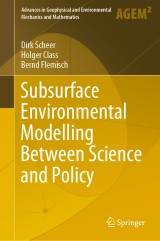Details

Subsurface Environmental Modelling Between Science and Policy
Advances in Geophysical and Environmental Mechanics and Mathematics
|
96,29 € |
|
| Verlag: | Springer |
| Format: | |
| Veröffentl.: | 25.07.2020 |
| ISBN/EAN: | 9783030511784 |
| Sprache: | englisch |
Dieses eBook enthält ein Wasserzeichen.
Beschreibungen
<p></p><p>This book provides a broad overview of essential features of subsurface environmental modelling at the science-policy interface, offering insights into the potential challenges in the field of subsurface flow and transport, as well as the corresponding computational modelling and its impact on the area of policy- and decision-making. The book is divided into two parts: Part I presents models, methods and software at the science-policy interface. Building on this, Part II illustrates the specifications using detailed case studies of subsurface environmental modelling. It also includes a systematic research overview and discusses the anthropogenic use of the subsurface, with a particular focus on energy-related technologies, such as carbon sequestration, geothermal technologies, fluid and energy storage, nuclear waste disposal, and unconventional oil and gas recovery.</p><p></p>
Introduction.- Environmental engineering applications related to flow and transport in the subsurface.- Mathematical/numerical solution methods: An overview.- Numerical simulation: Implementation, data processing, software concepts.- The science-policy interface in subsurface environmental modelling.- Challenging subsurface modelling and policy-making.- Conclusions.
<p></p><p>This book provides a broad overview of essential features of subsurface environmental modelling at the science-policy interface, offering insights into the potential challenges in the field of subsurface flow and transport, as well as the corresponding computational modelling and its impact on the area of policy- and decision-making. The book is divided into two parts: Part I presents models, methods and software at the science-policy interface. Building on this, Part II illustrates the specifications using detailed case studies of subsurface environmental modelling. It also includes a systematic research overview and discusses the anthropogenic use of the subsurface, with a particular focus on energy-related technologies, such as carbon sequestration, geothermal technologies, fluid and energy storage, nuclear waste disposal, and unconventional oil and gas recovery.</p><p></p>
Highlights the interdisciplinary research on subterranean energy technology by geoscientists, modellers and social scientists Offers insights into the anthropogenic use of the subsurface to help stakeholders and policymakers to decide on such issues in the future Presents the fundamentals of numerical simulation, increasing readers’ understanding of environmental problems in the subsurface and promoting knowledge transfer at the science–policy interface

















